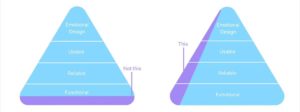
Correcting Common Misconceptions About the “Minimum Viable Product”
Everyone has their own interpretation of what minimum viable product (MVP) means to their organization. While the specifics of a company’s MVP may vary, there are key components of what a traditional MVP is, and what it definitely is not.
A successful MVP is critical to building a successful digital product: It’s the focused feature set that gets your product to market, sets the tone for the future of your product, and helps to guide you toward prioritized improvements on the product roadmap. It’s the initial version that gets your product to market and allows you to iterate, get feedback, and narrow in on product/market fit. Your MVP is not the bare minimum, nor the maximum number of features – it’s somewhere in the middle.
Here are a few things that an MVP definitely is not.
Bare Bones
20 years ago, your new digital product was often the first to market. There were fewer digital options than today, and user experience expectations were lower. Today, consumer tastes and expectations have changed. And so has the market (we’ve written a guide on how to define the first version of your digital product).
When there are dozens of other competitors with similar product offerings, you need to make your MVP more intuitive and aesthetically pleasing than the competition. It shouldn’t just work. It should solve real problems, and look good while doing it.
Your MVP shouldn’t just work. It should solve real problems, and look good while doing it.
Today, if people can’t easily figure out how to use a product, they will move on. If they don’t see value quickly, they will move on. Because of that, you need to make an MVP that gets the job done quickly and easily.

A One-and-done
Digital products are not a one-and-done build. No matter how much experience you have, there will be features you miss or get wrong in your first version.
You will get feedback on your MVP, which means you’ll need to go back to the drawing board to improve the product. If you think your first try will be perfect and won’t need any changes, you will be disappointed. Much like a home, digital products require ongoing improvements and maintenance. So even if your MVP is enjoyed by your users, you will eventually need to “repair the appliances” and “add a guest bedroom” to continue to grow with their expectations and ensure they keep coming back.
The Perfect Product
While your MVP shouldn’t just be the bare bones of your idea, it also shouldn’t be all of your ideas. If you spend three years fully building out every feature of your dream product then take that “MVP” product to market, you will likely be disappointed by the result. You may find that features you thought would be core aspects of your product are actually just confusing and pointless to your users.
That means you spent three years building something your users don’t even want. That’s a big waste of time, and money.
Prioritize a product MVP that addresses the key problems your users need solved, get it to market, and get feedback. Repeat this strategy and iterate over time. Feedback and iteration will mitigate risk. It will help you build a user-driven product. Addressing problems in small, incremental improvements will ensure that you’re creating a valuable product for the people who actually use the product.
Prioritize a product MVP that addresses the key problems your users need solved, get it to market, and get feedback. Repeat this strategy and iterate over time.
While your personal definition of a minimum viable product may vary, be sure that you are not working toward one of these common misconceptions. Define your MVP by starting with the long-term business goals and working backwards. Prioritize ruthlessly, and avoid the trap of having an MVP that is bare bones or over the top. And don’t forget to obsessively gather feedback so you can continue to maintain and improve your product over time.



